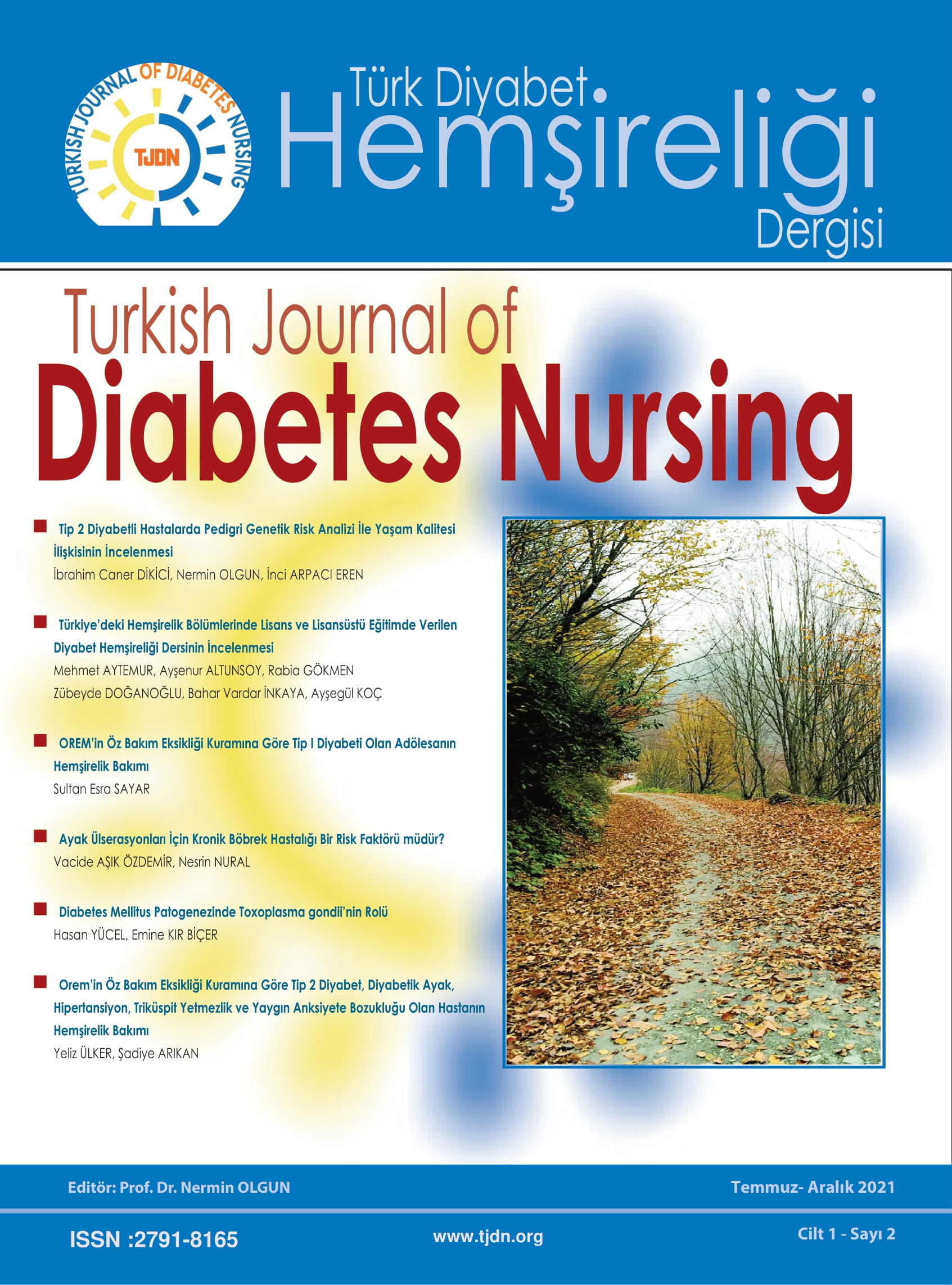Orem’in Öz Bakım Eksikliği Kuramına Göre Tip 2 Diyabet, Diyabetik Ayak, Hipertansiyon, Triküspit Yetmezlik ve Yaygın Anksiyete Bozukluğu Olan Hastanın Hemşirelik Bakımı
Author :
Abstract
Tip 2 diyabet Hastaların uyumsuzlukları ve eşlik eden komorbiditelerin varlığı; sağlık profesyonellerinin verdiği eğitimlerin devamlılığını ve hastanın tedaviye ve eğitimlere uyum sürecini bozabilir. Bu kapsamda hemşirelik kuram ve modellerinin kullanımı sağlık profesyonelleri için bir çerçeve belirleyerek ilerlemesinde yol gösterici olmaktadır. Hemşirelik uygulamalarının kanıta dayalı olması, bakım kalitesini ve bakım sonuçlarını iyileştirmek, klinik uygulamalarda ve hasta bakım sonuçlarında fark yaratmak, bakımı standardize etmek ve hemşire memnuniyetini artırmak gibi sonuçlar açısından önemlidir. Orem’in Öz Bakım Eksikliği Kuramı hemşirelerin bakım uygulamalarında en sık başvurduğu kuramlardandır. Orem’in Öz Bakım Eksikliği Kuramına göre birey gelişme ve öğrenme potansiyeline sahiptir. Bireyler öz bakım davranışlarını gerçekleştiremiyorsa hemşire bireyin öz bakım davranışlarının yeterli hale gelmesi konusunda bireye destek olur, gerekli durumlarda da bireyin öz bakım davranışlarını üstlenir. Tip 2 diyabetli hastaların gelişen akut veya kronik komplikasyonlar nedeniyle zaman zaman hastane yatışlarının olması, istenmeyen enfeksiyonlar ve kan glikoz regülasyonu problemleri ile karşılaşmaları eğitsel hemşirelik yaklaşımlarına gereksinim duyduklarını göstermektedir. Bu olguda Tip 2 diyabet, evre 2 diyabetik ayak ve yaygın anksiyete bozukluğu bulunan hastaya yatış esnasında hipertansiyon ve triküspit yetmezlik tanılarının da eklenmesi ile hastanın bakım planı Orem’in Öz Bakım Eksikliği Kuramına göre incelenmiştir.
Keywords
Abstract
It is aimed that the training given to patients with type 2 diabetes within certain periods from the moment of diagnosis will turn into self-care behaviors and complications will not develop. Incompatibility of patients and the presence of accompanying comorbidities may disrupt the continuity of education provided by healthcare professionals and the patient's compliance with treatment and training. In this context, the use of nursing theories and models determines a framework for health professionals and is indicative of their progress. Nursing theories and models contribute to the development of the nursing profession and to increase the quality of care given by health professionals. Orem's Self-Care Deficit Theory is one of the most frequently used theories by nurses in their care practices. According to Orem's Self-Care Deficit Theory, the individual has the potential to develop and learn. If individuals are unable to perform self-care behaviors, the nurse supports the individual in making the individual's self-care behaviors sufficient, and undertakes the individual's self-care behaviors when necessary. The fact that patients with type 2 diabetes are hospitalized from time to time due to developing acute or chronic complications, encountering unwanted infections and regulation problems shows that they need educational nursing approaches. In this case, the patient's care plan was planned according to Orem's Self-Care Deficiency Theory, with the addition of the diagnosis of Hypertension and tricuspid insufficiency during hospitalization for the patient with type 2 diabetes, stage 2 diabetic foot and generalized anxiety disorder.
Keywords
- 1. Erilmez, C. (2018). Tip 2 diyabetli hastaların öz-bakım gücünün değerlendiril- mesi (Master’s thesis, Eastern Mediterranean University (EMU)-Doğu Akdeniz Üniversitesi (DAÜ).Kıbrıs.
- 2. Hainer, V., Toplak, H. Mitrakou A. (2008). Treatment modilities of obesity. Diabetes Care. 31: (Supplement_2):S269–S277.
- 3. Karakurt, P., Aşılar, R. H., Yıldırım, A., Uygun, V., Tayfun, F., Akcan, M., ... Bozkurt, G. (2013). Diyabetli hastalarin öz-bakim gücü ve algiladiklari sosyal desteğin değerlendirilmesi. Collections, 14(1), 10.
- 4. Lloyd, C.E. & Brown, F.J. (2002). Depression and diabetes. Current Women’s Health Reports, 2, 188–19.
- 5. Menekli, T., Kokmaz, M. (2021). Dahiliye hemşirelerinin kanıta dayalı hemşire- liğe yönelik tutumları. Dokuz Eylül Üniversitesi Hemşirelik Fakültesi Elektronik Dergisi, 14(1), 38-47.
- 6. Olgun, N., Aslan, F. E., Coşansu, G., Çelik, S. (2017). Diabetes Mellitus. Karada- kovan, A., Aslan F.E. (Ed.). Dahili ve Cerrahi Hastalıklarda Bakım (ss.767-804). Ankara: Akademisyen Kitabevi.
- 7. Şahin, S. (2018). Tip 2 diyabetli hastalarda ayak yarası riski, ayak öz-bakım dav- ranışları ve hastalık kabulü arasındaki ilişkinin belirlenmesi (Master’s thesis, Necmettin Erbakan Üniversitesi Sağlık Bilimleri Enstitüsü).Konya.
- 8. Şengün, F., Üstün, B., Bademli, K. (2013). Türkiye’de kuram/modele dayalı hemşirelik araştırmalarının incelemesi. Anadolu Hemşirelik ve Sağlık Bilimleri Dergisi, 16(2), 132-139.
- 9. Üstündağ, Ş., Dayapoğlu, N.(2021). Tip 2 diyabetli bireylerin hastalık yöneti- minde karşılaştıkları engellerin değerlendirilmesi. Adnan Menderes Üniversitesi Sağlık Bilimleri Fakültesi Dergisi, 5(3), 514-533.
- 10. Yıldırım, A., Çevik, B. (2016). Diyabetik ayak vaka örneğinde hemşirelik ge- reksinimlerinin Orem özbakım kuramına göre değerlendirilmesi. Sürekli Tıp Eğitim Dergisi. 25, 205-212
- 11. Zeren, F. G. (2021). Diyabetes mellituslu bireylerin aile desteği ile öz bakım dü- zeyleri arasındaki ilişki (Master’s thesis, Necmettin Erbakan Üniversitesi Sağlık Bilimleri Enstitüsü).Konya
- 12. Türkiye Diyabet Tanı ve Tedavi Rehberi. (2021). https://www.turkdiab.org/ad- min/PICS/webfiles/Diyabet_Tani_ve_Tedavi_Rehberi_2021.pdf (Erişim Tarihi: 5.11.2021)
- 13. Türkiye Endokrin Metabolizma Derneği. (2020). https://temd.org.tr/ (Erişim Tarihi: 5.11.2021)
- 14. International Diabetes Federation Atlas (2021). https://idf.org/e-library/epi- demiology-research/diabetes-atlas.html (Erişim Tarihi:10.11.2021)





